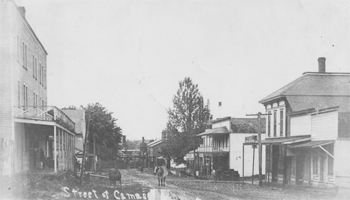July 21,1974
The late A.O. Hathaway, pioneer land developer who claimed to be around at the time, always gave this version of how Camas came to be.
“Henry Pittock was out in a rowboat on Lacamas Lake. He leaned over the side, looked at the water, and said this would be a great place for a paper mill.”
However accurate Hathaway’s memory might have been, it is certain that something close to that must have happened, for Pittock and his newspaper, The Oregonian, were responsible for founding the city in 1883.
The Lacamas Colony Co. had been organized in Portland with Pittock as president. On May 12, 1883, the company purchased the present town site. Their purchase took in Lacamas, Round and Fallen Leaf lakes and Lacamas Creek all the way to the Columbia River.
In its issue of Jan. 4, 1884, The Oregonian ran a major story on the development.
“Conservative businessmen of Portland have bought a tract of about 3,000 acres of land, covering the bank of the Columbia, the banks of the Washougal and Lacamas rivers and the shores of Lake Camas, and are developing the idea of an industrial colony on a purely business basis,” Pittock’s paper said.
The foundations of Camas had been laid nearly 40 years earlier, however, when an immigrant, Jacob Hansaker, built a sawmill on the present site of the city. His mill burned, but the Hudson’s Bay Co. built another there in 1851 and in 1852 Hamilton J.G. Maxon built a mill about a quarter-mile upstream from the mouth of Lacamas Creek.
In 1864, Maxon and his wife, Arabella, received a donation land claim title to one square mile that takes in the present city and mill.
Town platted
After purchasing some 2,600 acres, the Portland-based Lacamas Colony Co. had the new town platted on Sept. 10, with 60 blocks, and started to build a paper mill.
To provide water for this mill, a 7,000-foot aqueduct was built from Round Lake to the mill site. This aqueduct, locally called the “mill ditch,” remains in use 110 years later, much of it in the form of a tunnel which passed beneath Camas school athletic fields to emerge on the brow of the hill overlooking downtown Camas.
The founding year of 1883 also saw the first business open in the new town of LaCamas. First among these was built by Aeneas MacMaster, whose wooden store building was open for business in September. Later, the structure was incorporated into the paper mill offices.
Land developer Pittock also was publisher of The Oregonian and was looking for a new supply of newsprint.
Mill incorporates
The Columbia River Paper Co. was incorporated at LaCamas on March 14, 1884, and the Washington Territory had its first paper mill. Along with the water-powered paper mill, LaCamas also got a sawmill, capable of cutting 30,000 board feet of lumber per day.
Within two years of being founded, the village of LaCamas was starting to resemble a full-blown town. The Vancouver Independent of Jan. 15, 1885, reported LaCamas now supported a Presbyterian and a Methodist-Episcopal church, a lodge, a meeting hall and a public pavilion, used for dances and other entertainment.
The struggling little community suffered a major setback the following year when, on Nov. 6, 1886, the paper mill burned to the ground, along with 105 tons of finished paper. The loss was estimated at $95,000, less than half of it covered by insurance.
However, the company began rebuilding almost immediately and soon the mill was making more paper than ever.
Meanwhile, LaCamas had been making spectacular growth. A school district had been organized by the end of 1883. Funds were raised by private subscription for a one-room school building which ran for three months in 1884. Elizabeth McMaster taught 20 pupils in the crude structure.
Hotels active
The community’s first hotel, the LaCamas, opened for business at First and Columbia streets.
In 1889, just prior to statehood, the Washington State Grange was founded in a meeting held in MacMaster’s building in LaCamas. After organizing, the farmer-delegates passed their first resolution, one opposing the proposed new state constitution because it called for “more officers than public service requires with the salaries fixed too high and no provision for reductions.”
The first post office was opened on Feb. 7, 1884, and the first postmark was LaCamas, Clarke Co., Wash. Terr. The town had been named after a term used by the French at Fort Vancouver who referred to a lily which grew in local prairies as “la kamass” or “la camas.”
Ten years later, however, the name was shortened to Camas.
